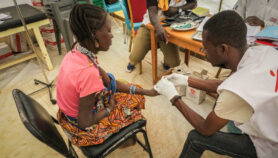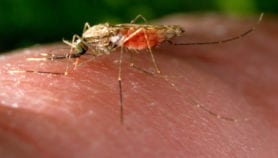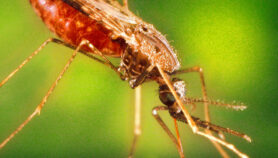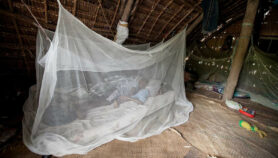By: Esther Nakkazi
Send to a friend
The details you provide on this page will not be used to send unsolicited email, and will not be sold to a 3rd party. See privacy policy.
A ‘home-dipping’ kit that allows people in remote communities to treat their mosquito nets with insecticide has passed a stringent safety test in Tanzania.
The ICON® Maxx dipping kit uses a solution containing the lambda-cyhalothrin pesticide that, according to the developers, is not dangerous to humans. Field trials involving villages in Muheza and Moshi provinces showed the kit can be used safely and greatly increases the number of mosquitoes warded off and killed by the nets.
“It is a simple procedure that can be adopted by anyone regardless of their education level.”
Patrick Tungu, National Institute for Medical Research
The researchers found that nets treated with the solution remained poisonous to mosquitos for up to 36 months. This compared well to conventional nets treated with an insecticide mix called CTN, which usually stops being efficient after around a year of use and regular washing.
The ICON® Maxx kit was tested for safety by observing volunteers who, for six weeks, slept under the treated nets in special huts constructed in their communities. They were also encouraged to wash their nets as usual, and dip them regularly using the instructions provided with the kit.
Patrick Tungu, a researcher at Tanzania’s National Institute for Medical Research and one of the study’s leaders, said the trials showed that the kits are safe.
“It does not require technical expertise to impregnate a net,” he says. “It is a simple procedure that can be adopted by anyone regardless of their education level.”
The kits contain two sachets, one with the insecticide and one with a binding agent. A kit to treat one bed net currently costs US$3, which is considered affordable for villagers.
The researchers hope that this will encourage the regular dipping of nets in insecticide — particularly in communities that do not have easy access to conventional providers of this service.
Mosquito nets are widely used across the globe to prevent the transmission of malaria, as they are cheaper than prophylactic medicine. But nets sold in remote areas of sub-Saharan Africa are usually untreated, and even the treated ones lose their effectiveness after several washes, according to health authorities.
Anthony Nuwa, a technical coordinator at the Uganda branch of the Malaria Consortium, an NGO focussing on malaria eradication, says that the kit could fill a gap in areas where there are shortages of professional dipping services, thus reducing the number of malaria deaths in the poorest areas of sub-Saharan Africa.
“It is good news,” he told SciDev.Net.Malaria is estimated to kill around one million people a year. Vector control — the curtailing of the malaria parasite’s spread from mosquitoes to humans — is one of the main elements of the World Health Organization’s strategy to combat the disease.
However, this has recently been hampered by the parasite’s growing resistance to conventional poisons.
“The biggest threat to malaria vector control now is insecticide resistance,” says Ambrose Talisuna, a malaria researcher at the University of Oxford in the United Kingdom. He says that the ICON® Maxx insecticide would add a “new tool” to existing malaria control efforts.














